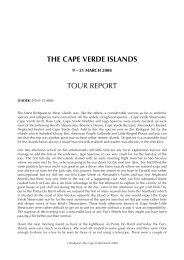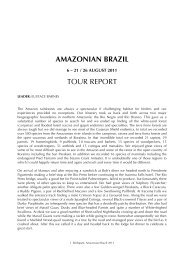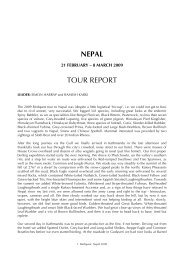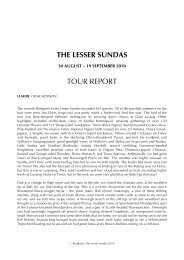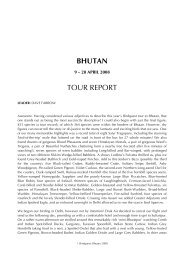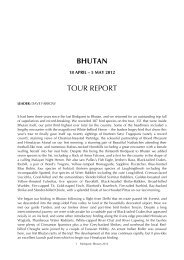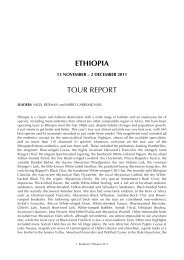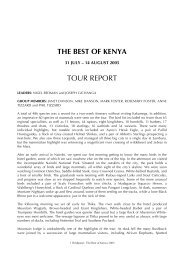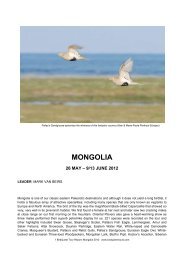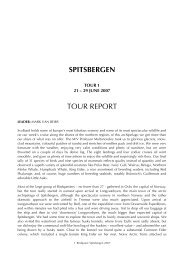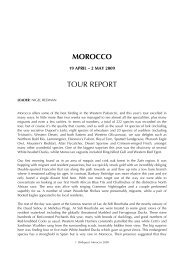Download Full Tour Report 1202kb - Birdquest
Download Full Tour Report 1202kb - Birdquest
Download Full Tour Report 1202kb - Birdquest
You also want an ePaper? Increase the reach of your titles
YUMPU automatically turns print PDFs into web optimized ePapers that Google loves.
White-banded Swallow Atticora fasciata: An elegant looking swallow that we enjoyed regularly in<br />
the lowlands.<br />
Southern Rough-winged Swallow Stelgidopteryx ruficollis: Small numbers were seen fairly regularly<br />
in the lowlands.<br />
Brown-chested Martin Phaeoprogne tapera: Numerous during our boat journeys on the Rio Manu<br />
and the Madre de Dios.<br />
Grey-breasted Martin Progne chalybea: Small numbers seen on the Rio Madre de Dios.<br />
White-winged Swallow Tachycineta albiventer: Numerous over rivers and oxbow lakes.<br />
TROGLODYTIDAE<br />
Scaly-breasted Wren (Southern Nightingale-Wren) Microcerculus marginatus: Most of us succeeded<br />
in seeing this ear-splitting forest floor phantom in Manu National Park.<br />
Grey-mantled Wren Odontorchilus branickii: We had two separate sightings in the Kosñipata valley.<br />
Southern House Wren Troglodytes musculus: Scattered sightings in the highlands and lowlands.<br />
Mountain Wren Troglodytes solstitialis: Three sightings of birds accompanying mixed flocks in the<br />
cloud forest. Two races intergrade in the area, the Peruvian macrourus and the Bolivian<br />
frater.<br />
Thrush-like Wren Campylorhynchus turdinus: A group of three birds was seen quite readily at<br />
Pantiacolla Lodge.<br />
Inca Wren Thryothorus eisenmanni: A pair showed extremely well near the road below Machu<br />
Picchu. A restricted-range endemic. Named for Eugene Eisennmann (1906-1981), who<br />
made a tremendous contribution to Neotropical ornithology as a life-long research<br />
associate of the American Museum of Natural History.<br />
Moustached Wren Thryothorus genibarbis: Heard often but finally this skulker showed well in the<br />
bamboo near Manu Wildlife Centre.<br />
Buff-breasted Wren Thryothorus leucotis: We had good views of this species on the outskirts of<br />
Puerto Maldonado.<br />
Fulvous Wren Cinnycerthia fulva: We caught up with this specialty wren in the Manu cloud forest<br />
with a bit of perseverance.<br />
Grey-breasted Wood-Wren Henicorhina leucophrys: Good views of at least two birds in the cloud<br />
forest. Here the nominate race, more than one species likely being involved.<br />
Chestnut-breasted Wren Cyphorhinus thoracicus: This one proved as difficult as ever with only a few<br />
of us glimpsing one bird below Cock-of-the-Rock Lodge.<br />
Musician Wren Cyphorhinus arada: Eventually we all had good looks at this sometimes shy species<br />
in Manu National Park.<br />
POLIOPTILIDAE<br />
Half-collared Gnatwren Microbates cinereiventris: A family group at Amazonía Lodge showed fairly<br />
well but as usual they moved quite quickly through the understorey.<br />
DONACOBIIDAE<br />
Black-capped Donacobius (B-c Mockingthrush) Donacobius atricapillus: Good views of this<br />
charismatic bird at Amazonía Lodge, Romero and Cocha Camungo. Formerly included<br />
with the wrens, recent genetic data link it with the old world Sylvioidea, its closest<br />
relative family being the Megaluridae (grassbirds, etc).<br />
CINCLIDAE<br />
White-capped Dipper Cinclus leucocephalus: Three sightings in total from the Manu cloud forest and<br />
four additional birds were seen along the Urubamba River during the extension.<br />
TURDIDAE<br />
Andean Solitaire Myadestes ralloides (H): We heard several birds but never managed to find one on<br />
its perch.<br />
36 <strong>Birdquest</strong>: The Manu 20011




